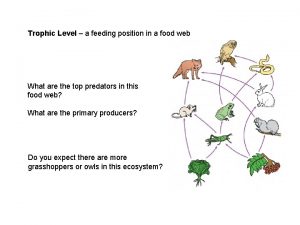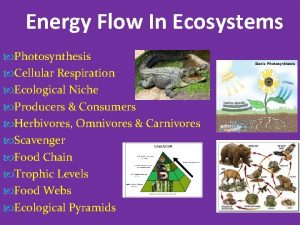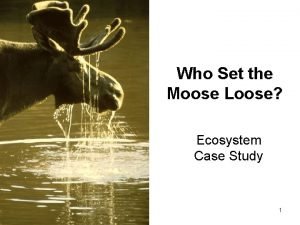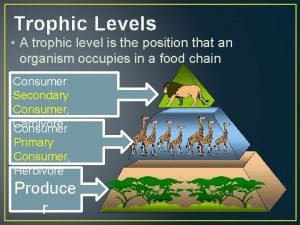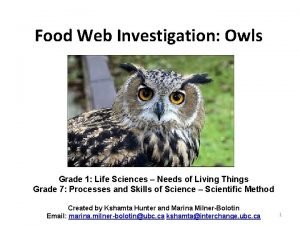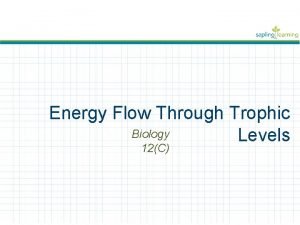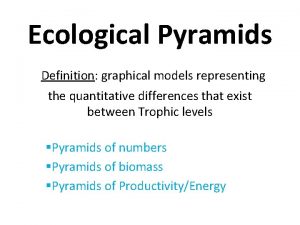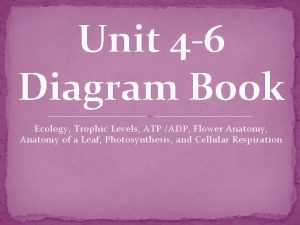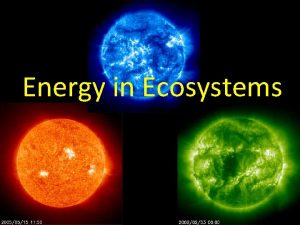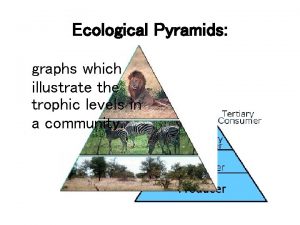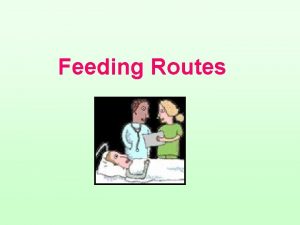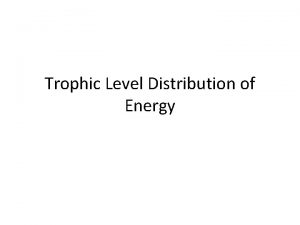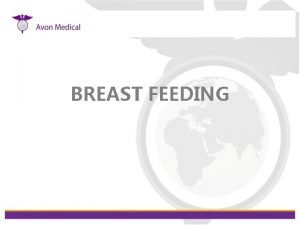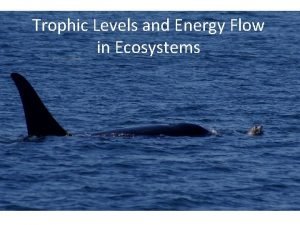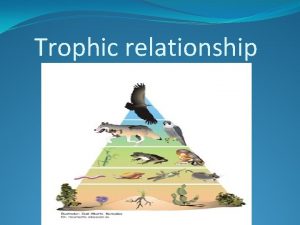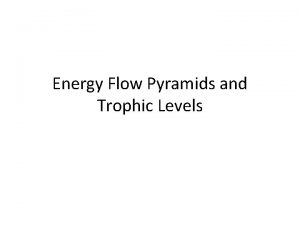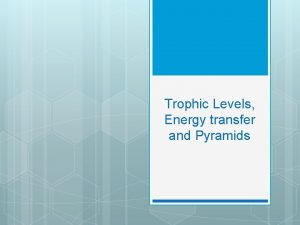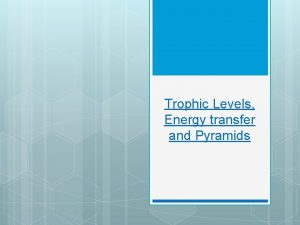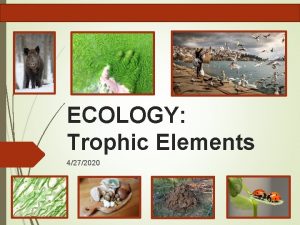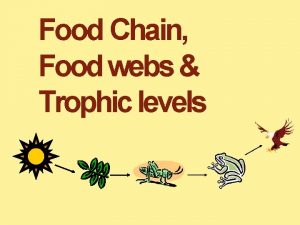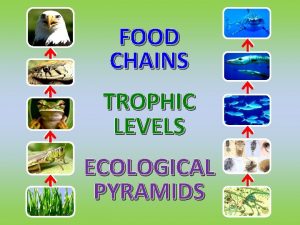Trophic Level a feeding position in a food




















- Slides: 20

Trophic Level – a feeding position in a food web What are the top predators in this food web? What are the primary producers? Do you expect there are more grasshoppers or owls in this ecosystem?

The relative energy in trophic levels in a Silver Springs, Florida, ecosystem is shown. Trophic Pyramid – a graphic representation of all the energy or biomass at each trophic level

Put the organisms from your Yellowstone food web into trophic levels. Trophic Level Primary producer Primary consumer Secondary consumer Tertiary consumer Quaternary consumer Organisms

Put the organisms from your Yellowstone food web into trophic levels. Trophic Level Organisms Primary producer trees, berries, nuts, grasses Primary consumer elk, deer, squirrel, mouse, vole Secondary consumer weasel, coyote Tertiary consumer wolf, grizzly bear Quaternary consumer Where do decomposers fit in a trophic pyramid?

Where do decomposers fit in a trophic pyramid?

Figure 27. 20 Distribution of biomass or energy at different trophic levels in an ecological system. Primary consumers are those animals that eat plants, also known as herbivores. A secondary consumer eats primary consumers, and a tertiary consumer eats secondary consumers. Secondary consumers and above are also known as carnivores or predators. The relative energy in trophic levels in a Silver Springs, Florida, ecosystem is shown.

Where does the energy in an ecosystem come from? ? ? photosynthesis energy comes from sunlight energy is stored in carbon-rich molecules


Where does the mass of a tree come from? CO 2 When you lose weight (mass), where does the weight go? CO 2

List the ways that CO 2 glucose • photosynthesis List the ways that glucose CO 2 • respiration (living organisms burning calories for work, giving off CO 2) • decomposition (respiration by decomposers) • combustion (burning wood & fossil fuels)


Figure 27. 23 Energy relationships in saltmarsh planthoppers and katydids. Estimates are from Teal (1962). He estimated 85% assimilation efficiency for planthoppers because they feed on liquid sugar solutions from plants (which are easy to digest), not cellulose (which is a plant structural chemical that is not easy to digest). The assimilation efficiency for grasshoppers, which consume mostly cellulose, was estimated to be 30%.

Are planthoppers or katydids better at converting food into animal body? (Calculate % production = production/consumption. ) Figure 27. 23 Energy relationships in saltmarsh planthoppers and katydids. Estimates are from Teal (1962). He estimated 85% assimilation efficiency for planthoppers because they feed on liquid sugar solutions from plants (which are easy to digest), not cellulose (which is a plant structural chemical that is not easy to digest). The assimilation efficiency for grasshoppers, which consume mostly cellulose, was estimated to be 30%. Which animal provides more energy for secondary producers to eat? Which animal loses more energy in feces? (Calculate % feces = feces/consumption)

Are planthoppers or katydids better at converting food into animal body? (Calculate % production = production/consumption. ) planthoppers = 70. 0/323. 5 = 21. 6% katydids = 10. 8/99. 4 = 10. 9% Figure 27. 23 Energy relationships in saltmarsh planthoppers and katydids. Estimates are from Teal (1962). He estimated 85% assimilation efficiency for planthoppers because they feed on liquid sugar solutions from plants (which are easy to digest), not cellulose (which is a plant structural chemical that is not easy to digest). The assimilation efficiency for grasshoppers, which consume mostly cellulose, was estimated to be 30%. Which animal provides more energy for secondary producers to eat? planthoppers = 70. 0 kcal/m 2/year katydids = 10. 8 kcal/m 2/year Which animal loses more energy in feces? (Calculate % feces = feces/consumption) planthoppers = 48. 5/323. 5 = 15. 0% katydids = 70/99. 4 = 70. 4%

primary producers 36, 380 8200 cordgrass & algae primary consumers 422. 9 80. 8 planthoppers & katydids secondary consumers 28 5 consumption spiders, wrens & dragonflies production

What percent of the energy that is converted from sunlight to glucose by plants is converted into plant material (biomass)? 8200/36, 380 kcal/m 2/year = 22. 5% What happens to the energy that is converted from sunlight to glucose but not made into biomass? primary producers 36, 380 8200 cordgrass & algae primary consumers 422. 9 80. 8 planthoppers & katydids secondary consumers 28 5 consumption spiders, wrens & dragonflies production it is used for activity/respiration What percentage of the available plant biomass is consumed by planthoppers & katydids? 422. 9/8200 kcal/m 2/year = 5. 2% What happens to the biomass that is not consumed by animals in a higher trophic level? is it consumed by decomposers after death

an emergent property of energy flow in ecosystems: Biomagnification

an emergent property of energy flow in ecosystems: Biomagnification https: //www. youtube. com/watch? v=E 5 P-Uo. KLxl. A

Figure 29. 14 Eggshell thickness in natural populations (circles) and in captive populations fed diets with different concentrations of DDE (Xes). Each point represents the mean for a clutch of eggs. From Lincer, 1975, Figure 3, © 1975 British Ecological Society.

Figure 29. 16 Relationship between concentration of DDE in eggs and percentage decrease in eggshell thickness in North American raptors and population status. The two Cooper’s hawk points are from the same population. * refers to fertile eggs, and † refers to broken eggs. From Lincer, 1975, Figure 4 and Table 4, © 1975 British Ecological Society.
 Specialized nutritional support
Specialized nutritional support Feeding positions in a food chain or web
Feeding positions in a food chain or web Second position
Second position Cray fish
Cray fish Who set the moose loose answer key
Who set the moose loose answer key Pyramids of energy transfer
Pyramids of energy transfer Trophic levels
Trophic levels Neumelinda
Neumelinda 10 rule of energy pyramid
10 rule of energy pyramid Tertiary consumer in a food web
Tertiary consumer in a food web Snowy owl trophic level
Snowy owl trophic level A graphical model of energy flow in a community
A graphical model of energy flow in a community Levels of consumers
Levels of consumers Marsh hawk trophic level
Marsh hawk trophic level Food pyramid biology
Food pyramid biology Ecological pyramid definition
Ecological pyramid definition Energy transfer efficiency between trophic levels
Energy transfer efficiency between trophic levels Leaf anatomy coloring worksheet answers
Leaf anatomy coloring worksheet answers A diagram that compares energy used by producers
A diagram that compares energy used by producers Strawberry plant
Strawberry plant Trophic level graph
Trophic level graph

